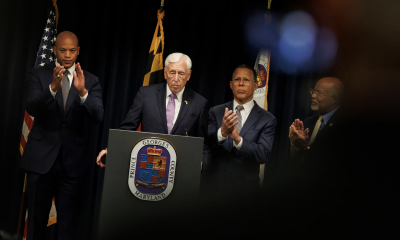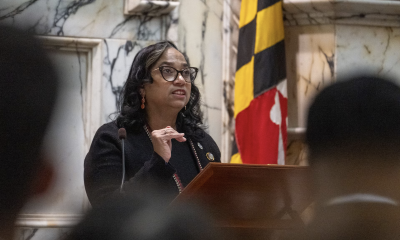a&e features
k.d. lang revisits her ‘Ingenue’ days in advance of Strathmore concert
Singer weighs in on coming out, her famous Vanity Fair shoot with Cindy Crawford and more
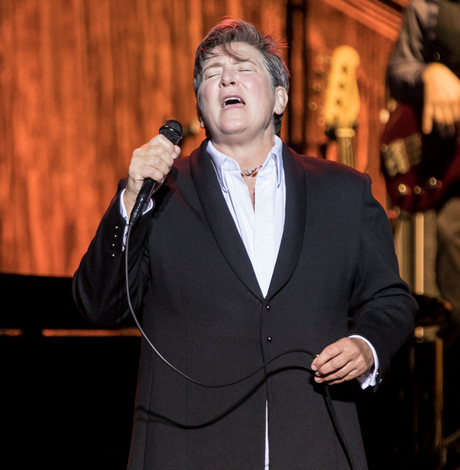
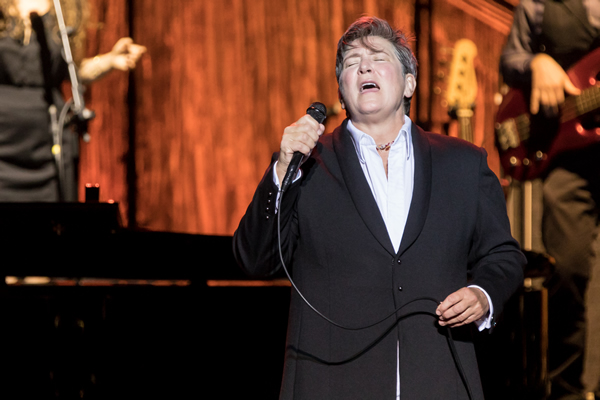
k.d. lang says she enjoyed revisiting her classic album ‘Ingenue’ on tour in Australia last year. (Photo by Matt Duboff)
k.d. lang
With the Grigoryan Brothers
“Ingenue Redux: 25th Anniversary Concert”
Sunday, March 25
Music Center at Strathmore
5301 Tuckerman Lane
North Bethesda, Md.
Tickets: $48-98
VIP meet-and-greet packages available
k.d. lang does not waste words. She’s delightful. Pleasant. She balks or hems at no question put to her.
Yet her economy of language is a bit startling.
So, of course, as any regular reader of celebrity profiles realizes, almost never is a Q&A a verbatim transcript of the conversation exactly as it went down. Quite often, in fact, we have to add a disclaimer that says so-and-so’s comments have been “slightly edited for length and clarity.”
But not with Miss lang. Aside from a few lines of opening pleasantries, this is the full chat. Verbatim.
She’s touring behind the 25th anniversary edition of her breakthrough album “Ingenue.” She plays the Strathmore on Sunday, March 25.
WASHINGTON BLADE: Where are you right now?
lang: Calgary, Alberta.
BLADE: I read you had moved to Portland a few years back. Do you still live there?
lang: Portland and Calgary. Back and forth.
BLADE: So “Ingenue” was such a change of pace for you musically. How much label convincing did that radical a change take? “Shadowlands” had done quite well I understand, so were they pushing for “Shadowlands part two” as they so often do or not?
lang: Yeah, uh, no, I was really successful at the time I switched because “Absolute Torch and Twang” won the Grammy Award for best country female vocalist and “Shadowland” I was the highest selling country album of that year and then I made “Ingenue. Um, I don’t remember them having an issue with it. I think they trusted me. I was signed to Sire Records, which was, you know, Madonna, Talking Heads, the Ramones, Chrissie Hynde. I was kind of from an alternative rock/punk label and I don’t think they had an issue with it. They trusted me and supported me. The issue was me coming out, really.
BLADE: Yeah, we’ll get to that. The only bonus material on the 25th anniversary edition for “Ingenue” is just your MTV Unplugged special. Why didn’t you put some b-sides if there were any, alternate vocals, demos, stuff like that on it?
lang: I didn’t really have any.
BLADE: Did you have the master tapes or were they sitting in some label warehouse somewhere all these years?
lang: Yeah, the label has them. But I didn’t even think about that and I don’t think we have any alternate takes because we just — I don’t think we have any. We just kept working on it until it was the finished deal.
BLADE: Was it a given that “Constant Craving” was going to be the first single? Did you and the label feel it had the most radio potential?
lang: Yeah, it was obvious to everyone that it was really the only one on the album that had any chance (chuckles).
BLADE: You’re credited with playing harp on “All You Can Eat” and “Watershed.” Is that like the big concert harp and how did you learn it?
lang: (chuckles again) I just make noise on the harp and it’s a tiny little one.
BLADE: So you never, like, studied the harp or took lessons or anything.
lang: No, no, no.
BLADE: Correct me if I’m wrong, but it seems like you did a ton of stuff for the LGBT groups in the ‘90s, like GLAAD, HRC but not so much in recent years. Do you get a lot of requests to make appearances from those kinds of groups anymore?
lang: I certainly did a lot back in the day, but no. I kind of, well obviously there’s a lot more people available to do the work now and I think I made my contribution and now I’m really just trying to walk the walk. I think I also wanted after years of being the spokesperson, you know, the poster “dykon,” I wanted the music to kind of come to the forefront again.
BLADE: Is it true your manager and label didn’t know you were going to do the Advocate interview when you came out? What was their immediate reaction?
lang: Well, they knew I was going to do the interview, but they didn’t know I was going to come out. Obviously people gave me their opinions but they knew I had to follow my heart and do whatever I felt was the right thing. They certainly supported me either way whether I came out or not. I think the obvious concern was that it would affect my career and it did, but in a very positive way.
BLADE: But did your manager say, like, “Gee, could you have at least given us a heads up?” or anything like that?
lang: No, no. They knew I was doing the interview and then as soon as I did, I let everyone know that I did, in fact, come out.
BLADE: So there was a chance you might have done an Advocate interview and not come out?
lang: Yeah, there was that chance but I pretty much knew that was the right place to do it.
BLADE: What’s it been like on this tour singing “Ingenue” straight through. It’s such a restrained album and you’ve talked about it almost requiring a classical-type approach. So often records sound great at home on the stereo but making that work live in a room is a whole other thing, especially an album like this I would imagine.
lang: Yes, you’re absolutely right and I feel like it’s really my energy and presence and focus that translates to the audience so if I’m bored with it or if I’m doubting myself, I think people pick up on that so it’s really up to me and the musicians to deliver it with absolute truth and integrity. I try to do that anyway, but especially, like you said, when you’re doing a record in sequence, you know, it’s a lot for an audience to digest. But I also think the fact that the audience has had 25 years to develop their own relationship with the record, it creates a space anyway and I never try to superimpose my relationship or my emotions on the song to supersede that of the listeners. I really try to deliver it in a way that everyone can relieve their experiences with the record.
BLADE: How did it go when you were touring it in Australia and Canada last fall?
lang: Very, very well. It was really for me, a beautiful musical experience. Really wonderful interplay with the band and with the audience and, you know, it’s a pretty quiet, pretty introspective show. It’s not in-your-face entertainment, stars show 101. But it’s pretty musical.
BLADE: Besides “Constant Craving,” had you done many of the other “Ingenue” songs much live over the years?
lang: Yeah, yeah, I’ve, you know, done “Save Me,” “Mind of Love,” “Wash Me Clean,” “Miss Chatelaine.” There’s always been a handful of songs in the rotation on any tour that I do from “Ingenue.”
BLADE: You originally toured that album over a year. How are the live arrangements different, or are they, from how you performed them back in ’92-’93?
lang: It’s a mix. Some are straight ahead exactly like the record which it’s also fun to kind of shadow the record, but some are very different so it’s a mix.
BLADE: How much of the vocal stuff you do live is improvised in the moment, like holding a certain phrase or using a different inflection on a lyric, or are some those little things the same each night?
lang: (pauses) Well, I definitely approach things different vocally. It depends how I feel, how my throat feels, how the hall sounds and how the audience is. If they’re rambunctious, I sing slightly different than if they’re very quiet. How the band is, what they’re throwing at me harmonically, so there’s a lot of variables. But I also get sort of attached to certain little phrases that I like to do every night, so I would say it’s a mix.
BLADE: How long did it take to shoot the famous Vanity Fair cover with Cindy Crawford? Was that an all-day thing or more like snap-snap-snap and you were done in an hour?
lang: Uh, no, it was probably like a full day’s work.
BLADE: Was it a fun process?
lang: Yeah, because we were all friends. I was really close to Herb (Ritts) at the time and Cindy was really close to Herb and I knew Cindy through Herb so it was just, you know, like we were just hanging out taking pictures. It was work, it was very professional, but it was also very easy.
BLADE: How did you like Tony Bennett’s album with Lady Gaga?
lang: I haven’t heard a lot of it but, um, I don’t — you know, it’s great, it’s awesome. I love those kinds of collaborations.
BLADE: I just find it interesting that you and Lady Gaga are the only female artists Tony Bennett has ever made full albums with.
lang: (chuckles) Yeah, we’re just different choices.
BLADE: It feels like there was this ‘90s wave of out women singers with you, Melissa Etheridge, the Indigo Girls, then it felt like there was this long, barren stretch before we got to, say, Tegan and Sara. Do you think maybe there was a backlash for a while and maybe female singers were a bit more skittish about coming out after that initial wave?
lang: (pauses) I’m afraid I can’t enlighten you on that one at all. I don’t know.
BLADE: Are you with anyone now?
lang: Yeah, I’m with somebody. I have a very nice home life.
BLADE: How long has this relationship been and does she ever tour with you?
lang: About four years and yeah, she comes out once in a while.
BLADE: OK great, thanks.
lang: Thank you, take care.
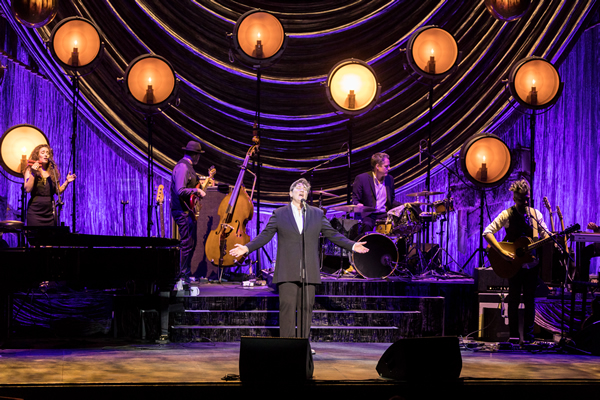
k.d. lang says several factors affect her vocal delivery on any given night. (Photo by Matt Duboff)
a&e features
Queer highlights of the 2026 Critics Choice Awards: Aunt Gladys, that ‘Heated Rivalry’ shoutout and more
Amy Madigan’s win in the supporting actress category puts her in serious contention to win the Oscar for ‘Weapons’

From Chelsea Handler shouting out Heated Rivalry in her opening monologue to Amy Madigan proving that horror performances can (and should) be taken seriously, the Critics Choice Awards provided plenty of iconic moments for queer movie fans to celebrate on the long road to Oscar night.
Handler kicked off the ceremony by recapping the biggest moments in pop culture last year, from Wicked: For Good to Sinners. She also made room to joke about the surprise hit TV sensation on everyone’s minds: “Shoutout to Heated Rivalry. Everyone loves it! Gay men love it, women love it, straight men who say they aren’t gay but work out at Equinox love it!”
The back-to-back wins for Jacob Elordi in Frankenstein and Amy Madigan in Weapons are notable, given the horror bias that awards voters typically have. Aunt Gladys instantly became a pop culture phenomenon within the LGBTQ+ community when Zach Cregger’s hit horror comedy released in August, but the thought that Madigan could be a serious awards contender for such a fun, out-there performance seemed improbable to most months ago. Now, considering the sheer amount of critics’ attention she’s received over the past month, there’s no denying she’s in the running for the Oscar.
“I really wasn’t expecting all of this because I thought people would like the movie, and I thought people would dig Gladys, but you love Gladys! I mean, it’s crazy,” Madigan said during her acceptance speech. “I get [sent] makeup tutorials and paintings. I even got one weird thing about how she’s a sex icon also, which I didn’t go too deep into that one.”
Over on the TV side, Rhea Seehorn won in the incredibly competitive best actress in a drama series category for her acclaimed performance as Carol in Pluribus, beating out the likes of Emmy winner Britt Lower for Severance, Carrie Coon for The White Lotus, and Bella Ramsey for The Last of Us. Pluribus, which was created by Breaking Bad’s showrunner Vince Gilligan, has been celebrated by audiences for its rich exploration of queer trauma and conversion therapy.
Jean Smart was Hack’s only win of the night, as Hannah Einbinder couldn’t repeat her Emmy victory in the supporting actress in a comedy series category against Janelle James, who nabbed a trophy for Abbott Elementary. Hacks lost the best comedy series award to The Studio, as it did at the Emmys in September. And in the limited series category, Erin Doherty repeated her Emmy success in supporting actress, joining in yet another Adolescence awards sweep.
As Oscar fans speculate on what these Critics Choice wins mean for future ceremonies, we have next week’s Golden Globes ceremony to look forward to on Jan. 11.
a&e features
Looking back at the 10 biggest A&E stories of 2025
‘Wicked,’ Lady Gaga’s new era, ‘Sexy’ Bailey and more

Although 2025 was a year marked by countless attacks on trans rights and political setbacks, the year also saw brilliant queer artists continuing to create art. From Cannes and Sundance Award winners now vying for Oscar consideration to pop icons entering new stages of their careers, queer people persevered to tell their stories through different media.
With the state of the world so uncertain, perhaps there’s no more vital time to celebrate our wins, as seen through some of this year’s top pop culture moments. While there’s no collection of 10 stories that fully encompass “the most important” news, here are some events that got the gays going:
10. ‘Mysterious Gaze of the Flamingo’ wins big at Cannes

The Cannes Film Festival has become a crucial start for films hoping to make their way to the Oscars, and first-time director Diego Céspedes won the top Un Certain Regard prize for his intimate western “The Mysterious Gaze of the Flamingo.” The film is set in the ‘80s and is intended as an allegory for the AIDS epidemic. Seeing a film that unpacks vital queer history win one of the most coveted awards at Cannes has been a huge point of pride in the independent filmmaking community.
Since the film bowed at Cannes, it has been selected as Chile’s Oscar entry in the Best International Feature race. Speaking with The Blade during the film’s AFI Fest run in October, Céspedes said: At first, I was kind of scared to have this campaign position in the times that we’re living [in] here. But at the same time, I think the Oscars mean a huge platform — a huge platform for art and politics.”
9. ‘The Last of Us’ returns for an even gayer season 2
While the first season of The Last of Us gave us one of TV’s most heartbreaking queer love stories in the episode “Long, Long Time,” Season 2 doubled down on its commitment to queer storytelling with the blossoming relationship between Ellie (Bella Ramsey) and Dina (Isabela Merced). The show expanded on the pair’s relationship in the original video game, making it perhaps the central dynamic to the entire season. That unfortunately came with more homophobic backlash on the internet, but those who checked out all the episodes saw a tender relationship form amid the show’s post-apocalyptic, often violent backdrop. For their performance, Ramsey was once again nominated for an Emmy, but Merced deserved just as much awards attention.
8. ‘Emilia Pérez’ sparks controversy
Jacques Audiard’s genre-bending trans musical “Emilia Pérez” proved to be an awards season juggernaut this time last year, winning the Golden Globe for Best Musical/Comedy. But when the lead star Karla Sofia Gascón’s racist, sexist, and homophobic old tweets resurfaced, the film’s Oscar campaign became a tough sell, especially after Netflix had tried so hard to sell Emilia Pérez as the “progressive” film to vote for. Mind you, the film had already received significant backlash from LGBTQ+ audiences and the Mexican community for its stereotypical and reductive portrayals, but the Gascón controversy made what was originally just social media backlash impossible to ignore. The only person who seemed to come out of the whole debacle unscathed was Zoe Saldaña, who won the Oscar for Best Supporting Actress over Ariana Grande.
7. ‘Sorry, Baby’ establishes Eva Victor as major talent
Back in January at the Sundance Film Festival, Eva Victor (known by many for her brand of sketch comedy) premiered their directorial debut “Sorry, Baby” to rave reviews, even winning the Waldo Salt Screening Award. Victor shadowed Jane Schoenbrun on the set of “I Saw the TV Glow,” and seeing Victor come into their own and establish such a strong voice immediately made them one of independent cinema’s most exciting new voices. A memorable scene in the film sees the main character, Agnes (played by Victor), struggling to check a box for male or female, just one example of how naturally queerness is woven into the fabric of the story.
Most recently, Victor was nominated for a Golden Globe for her performance in the film, and she’s represented in a category alongside Jennifer Lawrence (“Die My Love”), Jessie Buckley (“Hamnet”), Julia Roberts (“After the Hunt”), Renate Reinsve (“Sentimental Value”) and Tessa Thompson (“Hedda”). The film also received four Independent Spirit Award nominations overall.
6. Paul Reubens comes out in posthumous doc

While Paul Reubens never publicly came out as gay before passing away in 2023, the two-part documentary “Pee-wee as Himself” premiered back in May on HBO Max, giving the legendary comedian a chance to posthumously open up to the world. Directed by Matt Wolf, the documentary explores how Reubens found his alter ego Pee-Wee Herman and why he kept his private life private.
The documentary won an Emmy in the Outstanding Documentary or Nonfiction Special category and remains one of the most critically acclaimed titles of the year with a 100% Rotten Tomatoes score. Also worth noting, the National Geographic documentary Sally told the posthumous coming out story of Sally Ride through the help of her long-time partner, Tam O’Shaughnessy.
5. Lady Gaga releases ‘Mayhem’
Lady Gaga entered a new phase of her musical career with the release of Mayhem, her seventh album to date. From the frenzy-inducing pop hit Abracadabra to the memorable Bruno Mars duet featured on “Die With a Smile,” seeing Gaga return to her roots and make an album for the most die-hard of fans was especially rewarding after the underwhelming film releases of “House of Gucci” and “Joker: Folie à Deux.” Gaga has been touring with The Mayhem Ball since July, her first arena tour since 2018. She even extended her tour into 2026 with more North American dates, so the party isn’t stopping anytime soon. And Gaga is even set to make an appearance next May in “The Devil Wears Prada 2.”
4. Cynthia Erivo, Ariana Grande perform at the Oscars

While “Wicked: For Good” didn’t quite reach the heights of the first film, we will forever have Cynthia Erivo and Ariana Grande’s breathtaking live performance that opened the 97th Academy Awards. The pair sang a rendition of “Over the Rainbow,” “Home,” and “Defying Gravity,” paying proper homage to the original 1939 “Wizard of Oz.” Even non-Wicked fans can’t deny how magical and brilliantly staged this performance was. With both Erivo and Grande up for acting Oscars last year, they’re hoping to repeat success and make history with consecutive nominations. Either way, let’s hope there’s another live performance in the making, especially with two new original songs (The Girl in the Bubble and No Place Like Home) in the mix.
3. Indya Moore speaks out against Ryan Murphy
Indya Moore has consistently used social media as a platform for activism, and in September, posted a 30-minute Instagram live speaking out against “Pose” co-creator Ryan Murphy. Moore claimed that Murphy wasn’t being a true activist for trans people. “Ryan Murphy, we need you to do more. You need to address the racism, the violence, and the targeting of people on your productions, Ryan Murphy. You do need to make sure trans people are paid equally. Yes, Janet did the right thing,” Moore said. Murphy was also back in the headlines this year for the critically panned “All’s Fair” and the controversial “Monster: The Ed Gein Story” starring Laurie Metcalf and Charlie Hunnam.
2. Cole Escola wins Tony for Best Leading Actor
Few pop culture moments this year brought us together more than Cole Escola winning a Tony award for “Oh, Mary!” the Broadway show they created, wrote and starred in (we love a triple threat!) Escola made history by becoming the first nonbinary person to win a Tony in the leading actor category, and seeing them excitedly rush to the stage wearing a Bernadette Peters-inspired gown instantly became a viral social media moment.
The cherry on top of Escola’s major moment is the recent news that they are writing a Miss Piggy movie with Jennifer Lawrence and Emma Stone producing — news that also broke the internet for the better. We cannot wait!
1. Jonathan Bailey makes gay history as ‘Sexiest Man Alive’

The same year as his on-screen roles in blockbusters “Jurassic World Rebirth” and “Wicked: For Good,” Jonathan Bailey made history as the first openly gay man to be named People magazine’s “Sexiest Man Alive.” The fact that it took 40 years for an openly gay man to earn the title is a signifier of how far we still have to go with queer representation, and seeing Bailey celebrated is just one small step in the right direction.
“There’s so many people that want to do brilliant stuff who feel like they can’t,” he told PEOPLE, “and I know the LGBT sector is under immense threat at the moment. So it’s been amazing to meet people who have the expertise and see potential that I could have only dreamed of.” In 2024, Bailey founded the charity titled The Shameless Fund, which raises money for LGBTQ+ organizations.
a&e features
Your guide to D.C.’s queer New Year’s Eve parties
Ring in 2026 with drag, leather, Champagne, and more

With Christmas in the rear view mirror, we can turn our attention to ringing in a much-anticipated New Year with a slew of local LGBTQ parties. Here’s what’s on tap.
Pitchers
This spacious Adams Morgan bar is hosting the “Pitchers’ Perfect New Year’s Eve.” There will be a midnight Champagne toast, the ball drop on the big screens, and no cover, all night long. The bar doesn’t close until 4 a.m., and the kitchen will be open late (though not until close). All five floors will be open for the party, and party favors are promised.
Trade
D.C.’s hottest bar/club combo is leaning into the Shark motif with its NYE party, “Feeding Frenzy.” The party is a “glitterati-infused Naughty-cal New Year’s Even in the Shark Tank, where the boats are churning and the sharks are circling.” Trade also boasts no cover charge, with doors opening at 5 p.m. and the aforementioned Shark Tank opening at 9 p.m.. Four DJs will be spread across the two spaces; midnight hostess is played by Vagenesis and the two sea sirens sensuously calling are Anathema and Justin Williams.
Number Nine
While Trade will have two DJs as part of one party, Number Nine will host two separate parties, one on each floor. The first floor is classic Number Nine, a more casual-style event with the countdown on TVs and a Champagne midnight toast. There will be no cover and doors open at 5 p.m. Upstairs will be hosted by Capital Sapphics for its second annual NYE gathering. Tickets (about $50) include a midnight Champagne toast, curated drink menu, sapphic DJ set by Rijak, and tarot readings by Yooji.
Crush
Crush will kick off NYE with a free drag bingo at 8 p.m. for the early birds. Post-bingo, there will be a cover for the rest of the evening, featuring two DJs. The cover ($20 limited pre-sale that includes line skip until 11 p.m.; $25 at the door after 9 p.m.) includes one free N/A or Crush, a Champagne toast, and party favors (“the legal kind”). More details on Eventbrite.
Bunker
This subterranean lair is hosting a NYE party entitled “Frosted & Fur: Aspen After Dark New Year’s Eve Celebration.” Arriety from Rupaul Season 15 is set to host, with International DJ Alex Lo. Doors open at 9 p.m. and close at 3 p.m.; there is a midnight Champagne toast. Cover is $25, plus an optional $99 all-you-can-drink package.
District Eagle
This leather-focused bar is hosting “Bulge” for its NYE party. Each District Eagle floor will have its own music and vibe. Doors run from 7 p.m.-3 a.m. and cover is $15. There will be a Champagne toast at midnight, as well as drink specials during the event.
Kiki, Shakiki
Kiki and its new sister bar program Shakiki (in the old Shakers space) will have the same type of party on New Year’s Eve. Both bars open their doors at 5 p.m. and stay open until closing time. Both will offer a Champagne toast at midnight. At Kiki, DJ Vodkatrina will play; at Shakiki, it’ll be DJ Alex Love. Kiki keeps the party going on New Year’s Day, opening at 2 p.m., to celebrate Kiki’s fourth anniversary. There will be a drag show at 6 p.m. and an early 2000s dance party 4-8 p.m.
Spark
This bar and its new menu of alcoholic and twin N/A drinks will host a NYE party with music by DJ Emerald Fox. Given this menu, there will be a complimentary toast at midnight, guests can choose either sparkling wine with or without alcohol. No cover, but Spark is also offering optional wristbands at the door for $35 open bar 11 p.m.-1 a.m. (mid-shelf liquor & all NA drinks).
-

 District of Columbia4 days ago
District of Columbia4 days agoTwo pioneering gay journalists to speak at Thursday event
-

 Colombia4 days ago
Colombia4 days agoBlade travels to Colombia after U.S. forces seize Maduro in Venezuela
-

 a&e features4 days ago
a&e features4 days agoQueer highlights of the 2026 Critics Choice Awards: Aunt Gladys, that ‘Heated Rivalry’ shoutout and more
-

 National3 days ago
National3 days agoWhat to watch for in 2026: midterms, Supreme Court, and more

